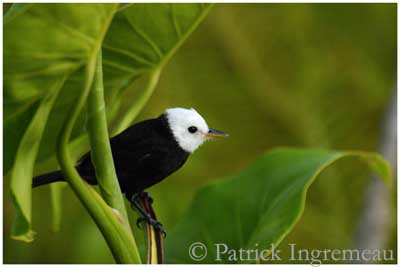
White-headed Marsh-Tyrant
Arundinicola leucocephala
Passeriforme Order - Tyrannidae Family
BIOMETRICS:
Length: 12-13 cm; Weight: 10-16 g
DESCRIPTION:
White-headed Marsh-Tyrant is a small passerine living in freshwater marshes.
Adult male is black and white. Its body is entirely blackish-brown, whereas head and upper breast are pure white. Crown is slightly crested.
The thin, pointed bill has yellow lower mandible and blackish upper mandible. Eyes are dark brown. Legs and feet are blackish.

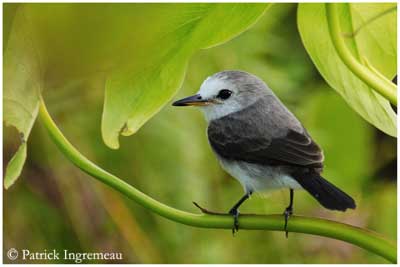
Female is paler. She has brownish-grey upperparts with blackish-brown wings and tail.
Underparts are white. Breast shows some indistinct pale grey streaks, as body sides and flanks.
Head is pale greyish-white, with pure white forehead, face and throat. Bill, eyes and legs are as in male.
VOICE: SOUNDS BY XENO-CANTO
White-headed Marsh-Tyrant is often quiet, but it can occasionally utter a sharp “sedik”. Call is a high-pitched “tzeek”. During flight displays, it repeats a low “dew-de-lewde”.
HABITAT:
White-headed Marsh-Tyrant lives in freshwater marshes and ponds, in reed beds and at the edges of mangrove swamps. It frequents marshy areas along streams. It is usually found below 500 metres of elevation.
RANGE:
White-headed Marsh-Tyrant is resident in tropical South America, living in Colombia, Venezuela, Trinidad and southwards, to Bolivia, Argentina and Paraguay.
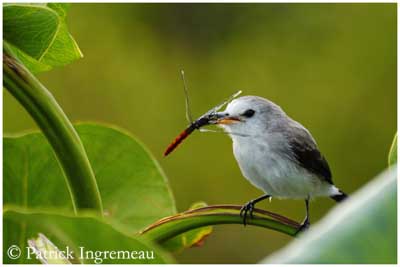
BEHAVIOUR:
White-headed Marsh-Tyrant is often seen perched in upright attitude on exposed perch, on bush top or on a snag over water, but usually on tall vegetation.
It feeds mainly on insects, and often sallies out to catch them in flight. It also picks off invertebrates from the marsh vegetation, but it prefers to catch them on the wing, or sometimes in shallow water. It returns immediately to its perch. It is rarely seen on the ground.
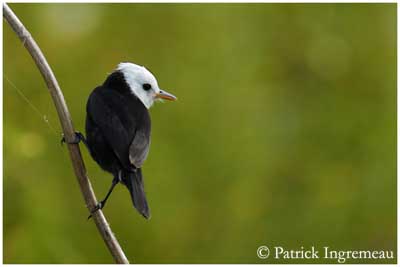
White-headed Marsh-Tyrant is usually seen in pairs or in small family groups throughout the year, but this bird may forage solitarily or with mate and young.
Birds of this family may engage some display behaviour, as during courtship or during aggressive disputes between males. In this case, the crest more or less conspicuous plays an important role, and according to the moment, the crest can be bushy or flattened.
Usually, all displays include the erected crest, performed in front of the rival or the mate. This behaviour is often accompanied by high vocalisations, and by different wing’s postures such as raised, fanned or fluttering.
They can also perform wing flapping while perched, in conjunction with strong calling and erected crest.
White-headed Marsh-Tyrant is resident within its range. Some local movements can be observed, according to the locality.
FLIGHT:
White-headed Marsh-Tyrant performs aerial sally for catching insects. It also performs elaborate aerial displays, flying above open area at about 10 to 15 metres above the ground, and hovering in the wind with raised wings while calling. The bird can be compared to a butterfly!
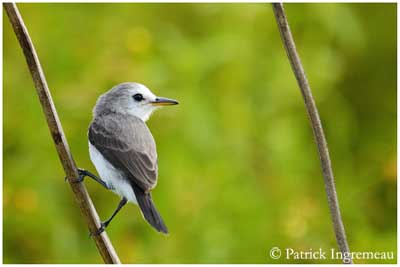
REPRODUCTION:
Breeding season varies, according to the locality.
Nest is usually situated low in bushes near or over water.
Both adults build the nest which is a globe-shaped structure, a kind of ball made with grasses and feathers. This nest is secured by several reeds, or attached to small branches of aquatic vegetation, usually at the end of the branch and over water.
We can see an entrance close to the top. This opening is usually concealed by a kind of vegetal “porch”. In order to protect the nest against predators, the entrance is relatively narrow and situated over stand water.
Female lays 2 to 3 creamy-white eggs, with brown spots. Incubation lasts about 12 to 16 days, shared by both adults.
Young are fed by parents and fledge about two weeks after hatching. They remain hidden into vegetation and often roost together, close to each other on a branch.
White-headed Marsh-Tyrant’s nest is often parasitized by Shiny Cowbirds (Molothrus bonariensis).
DIET:
White-headed Marsh-Tyrant feeds mainly on insects.
PROTECTION / THREATS / STATUS:
White-headed Marsh-Tyrant is fairly common in its range, and populations are not threatened at this moment.
Fr: Moucherolle à tête blanche
All : Weißkopf-Wassertyrann
Esp : Viudita Cabeciblanca
Ital : Tiranno testabianca
Nd : Witkop-watertiran
Photographs by Patrick Ingremeau
TAMANDUA
Text by Nicole Bouglouan
Sources:
HANDBOOK OF THE BIRDS OF THE WORLD Vol 9 - by Josep del Hoyo - Andrew Elliot - David Christie - Lynx Edicions - ISBN: 8487334695
A GUIDE TO THE BIRDS OF COLOMBIA by Steven L. Hilty and William L. Brown
Princeton University Press – ISBN 069108372X
Wikipedia (Wikipedia, The Free Encyclopedia)
Arthur Grosset's Birds (Arthur Grosset)